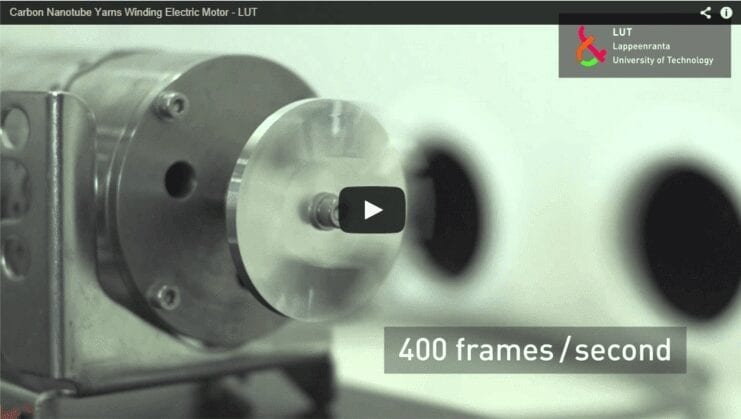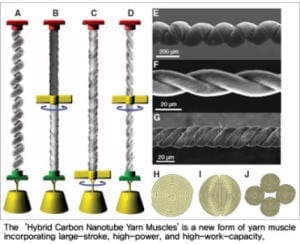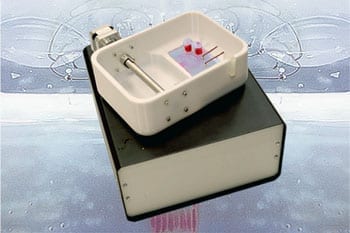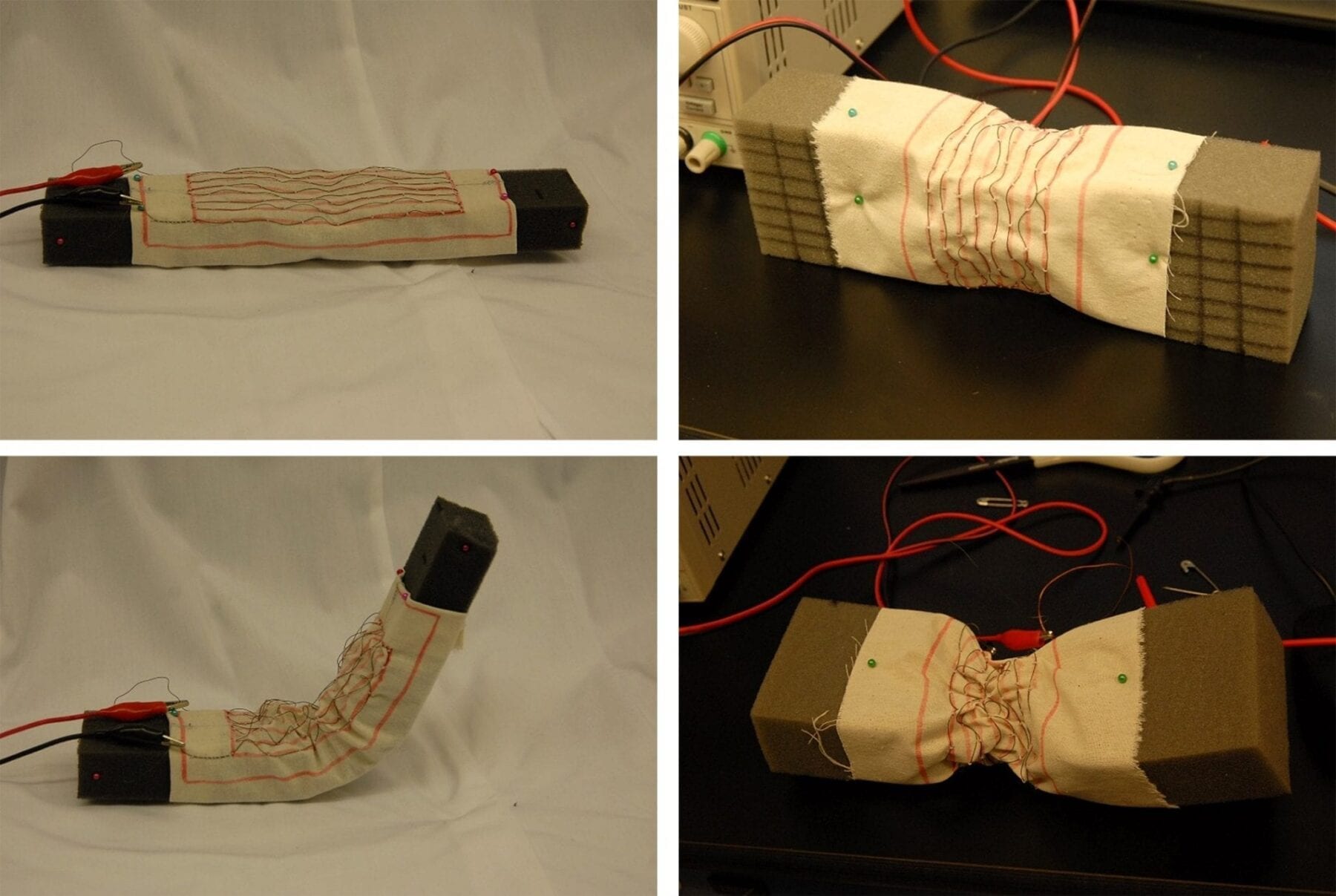
Engineers of LUT have constructed the world’s first electrical motor applying a textile material; carbon nanotube yarn.
The new technology may revolutionize the whole electrical machine industry
The presently most electrically conductive carbon nanotube yarn replaces usual copper wires in the windings. The motor prototype is built by the LUT Electrical Engineering group as a start towards lightweight, efficient electric drives.
The test motor output power is 40 W, it rotates at 15000 rpm, and has almost a 70 % efficiency. In the near future, carbon nanotube fibers have potential to significantly enhance the performance and energy efficiency of electrical machines. The new technology may revolutionize the whole industry.
Researchers are constantly searching for opportunities to upgrade the performance of electrical machines; to this end, one of the objectives is to find higher-conductivity wires for the windings. The best carbon nanotubes (CNTs) have demonstrated conductivities far beyond those of the best metals. Thus, future windings made of CNTs may have a double conductivity compared with the present-day copper windings. In order to make CNTs easy to manipulate, they are spun to form multifiber yarn.
“If we keep the electrical machine design parameters unchanged and only replace copper with future carbon nanotube yarns, it is possible to reduce the Joule losses in the windings to half of the present-day machine losses. Carbon nanotube yarns are significantly lighter than copper and also environmentally friendlier. Therefore, replacing copper with nanotube yarns should significantly reduce the CO2 emissions related to the manufacturing and operating of electrical machines. Furthermore, the machine dimensions and masses could be reduced. The motors could also be operated in significantly higher temperatures than the present ones,” says Professor Juha Pyrhönen, who has led the design of the prototype at LUT.
No definite upper limit for the conductivity
Traditionally, the windings in electrical machines are made of copper, which has the second best conductivity of metals at room temperature. Despite the high conductivity of copper, a large proportion of the electrical machine losses occur in the copper windings. For this reason, the Joule losses are often referred to as copper losses. The carbon nanotube yarn does not have a definite upper limit for conductivity (e.g. values of 100 MS/m have already been measured).
According to Pyrhönen, the electrical machines are so ubiquitous in everyday life that we often forget about their presence. In a single-family house alone there can be tens of electrical machines in various household appliances such as refrigerators, washing machines, hair dryers, and ventilators.
“In the industry, the number of electrical motors is enormous: there can be up to tens of thousands of motors in a single process industry unit. All these use copper in the windings. Consequently, finding a more efficient material to replace the copper conductors would lead to major changes in the industry,” tells Professor Pyrhönen.
The Latest on: Carbon nanotube yarn
[google_news title=”” keyword=”Carbon nanotube yarn” num_posts=”10″ blurb_length=”0″ show_thumb=”left”]
via Google News
The Latest on: Carbon nanotube yarn
- Titan likely imploded due to shape, carbon fiber: Scientistson May 1, 2024 at 1:29 pm
Most submersibles are spherical, allowing pressure to be evenly distributed around them, while the Titan was a cylindrical vessel to allow more space for passengers. While a perfectly shaped cylinder ...
- Scientists stencil-paint carbon nanotube components for flexible transparent electronicson April 23, 2024 at 9:23 am
Researchers from Skoltech, MIPT, and elsewhere have found a fast and inexpensive way to create geometric patterns in carbon nanotube films. The resulting films turned out to have superior properties ...
- Lightweight, Flexible Battery Paves the Way for Advanced Wearableson April 22, 2024 at 9:12 am
In a recent study published in Advanced Energy Materials, researchers from the Korea Institute of Science and Technology have developed a fiber-like electrode material using modified carbon nanotube ...
- Wearable Batteries Could Soon be Concealed in Strap! Researchers Create Fiber-Like Material That Can Store Energyon April 19, 2024 at 7:59 am
Researchers unveil fiber-like material storing energy, advancing wearable technology with the potential for seamless integration into everyday garments.
- Lightweight and flexible yet strong? Versatile fibers with dramatically improved energy storage capacityon April 18, 2024 at 9:02 pm
The figure above shows a comparison of the mechanical and electrical conductivity property enhancement of functionalized carbon nanotube fiber compared to raw fiber, showing a 33-fold increase in ...
- Versatile carbon nanotube fibers with dramatically improved energy storage capacityon April 18, 2024 at 5:00 pm
The team reports their findings in Advanced Energy Materials ("Active Material-Free Continuous Carbon Nanotube Fibers with Unprecedented Enhancement of Physicochemical Properties for Fiber-Type ...
- Recycling carbon fiber reinforced plastics waste is a challenge, but researchers find a way to make it workon April 18, 2024 at 12:30 pm
Carbon fiber reinforced plastics (CFRP) are lighter and stronger than metal and are used in a variety of industries, including aviation, aerospace, automotive, marine, and sporting goods. In recent ...
- Munich Composites Bringing Woven Carbon Fiber Rim Production to USAon April 17, 2024 at 11:59 am
North American brands now have a high-end woven carbon fiber RTM option for onshoring their rim manufacturing.
- 'Nanostitches' enable lighter and tougher composite materialson April 16, 2024 at 7:47 pm
In an approach they call 'nanostitching,' engineers used carbon nanotubes to prevent cracking in multilayered composites. The advance could lead to next-generation airplanes and spacecraft.
- “Nanostitches” enable lighter and tougher composite materialson April 16, 2024 at 12:12 pm
vertical rolls of carbon. The lab has previously shown that the nanotube forests can be grown and adhered to layers of composite material, and that this fiber-reinforced compound improves the ...
via Bing News











